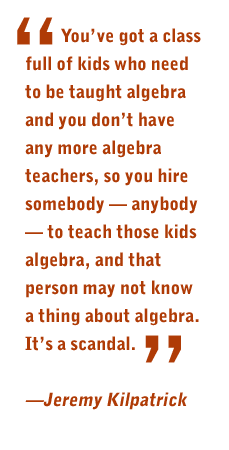


Building a Better Math Teacher
by Frank Stephenson
Intro
| Goal One: Teacher Quality/ Look Beyond the Ed Schools
| Toward a Deeper Understanding/ Show Us the Money


Toward a Deeper Understanding
In June 2004, the center held its second week-long institute (the first one took place during the preceding summer) that brought together teachers from colleges of education, academic mathematicians, practicing math teachers, principals and school district leaders from across the country for an intensive study of mathematics used in teaching grades K-8. The central idea behind the institutes is to assess the deficiencies in critical mathematics knowledge among teachers and to develop the best strategies for filling those gaps.
Meanwhile, the center is operating year-round on both campuses to help revise their respective Ph.D. programs in math education. It has catalyzed apprenticeships for doctoral students who regularly visit practicing teachers in their classrooms and soak up the real-world challenges of teaching math to young people coming from a variety of socioeconomic backgrounds. The center also has established groups of math teachers within schools who come together specifically to gain a broader, more in-depth appreciation of mathematics.
“Knowing mathematics is absolutely essential to becoming a good [math] teacher, but it’s not sufficient. There’s much more that’s needed,” Pat Wilson said. “What we’re especially interested in is defining what we mean by a deeper understanding of mathematics — which is what we see missing in the classrooms. Research mathematicians and engineers, for example, need a different kind of knowledge of mathematics than most teachers do. They don’t need as broad a knowledge as someone who is going to teach.”
In reaching toward a “deeper understanding” of math, Wilson said she believes that teachers need to look past what mathematics has come to be seen as — a highly compartmentalized discipline whereby labels such as “algebra,” “geometry,” “trigonometry” and “calculus” imply little or no connection with each other. In truth they are all branches of the same tree, nourished by the same underlying concepts.
The center-sponsored visits from doctoral students and regular meetings of math-teacher support groups help address the fact that acquisition of a deeper understanding often falls between the cracks. Too often math teachers don’t acquire it in college, Wilson said, and once on the job, it is even harder to achieve given the day-to-day demands on teachers’ time and the rare opportunities for continued education or professional development.
Essential to that deeper understanding is to move away from rote memorization — the bread-and-butter of standard math instruction since colonial days (and the bane of math-education reformers for decades). “What’s so dangerous is trying to memorize mathematics, because if you forget, you’re lost,” she said. “We want people to have a variety of ways to figure something out and have it make sense.”
Show Us the Money
New approaches for producing more qualified teachers can’t come soon enough for the nation’s 15,000 public school districts. The federal No Child Left Behind Act of 2002 requires all states to have certifiably qualified teachers in their classrooms by the end of the 2005-2006 school year. Teachers will be required to hold either an undergraduate degree in their subject areas or pass a rigorous national test. Given the woeful level of K-12 math training documented by repeated national surveys, however, meeting this requirement remains a supreme challenge.
Beyond the continuing noise from the “math wars” over how best to teach math not just to students but to would-be math teachers as well, Kilpatrick, an outspoken advocate of teacher preparedness, sees the whole dilemma as boiling down to a question of dollars and “sense.”
“Yes, we don’t have enough qualified teachers,” he said, “but you can get them if you have enough money. The widespread inequity in funding underlies the education problems we face as a country.
“Researchers have shown again and again that kids in the poor schools don’t do as well as those in the richer schools, which often are practically next-door. They don’t have the qualified teachers or the other resources they need. So it’s just another case of the rich getting richer and the poor getting poorer.”
For more information access http://www.cptm.us or e-mail Pat Wilson at pswilson@uga.edu, Jeremy Kilpatrick at jkilpat@uga.edu or Jim Wilson at jwilson@uga.edu.
Frank Stephenson, a Florida-based freelance writer, has won national awards for his writing.
Intro
| Goal One: Teacher Quality/ Look Beyond the Ed Schools
| Toward a Deeper Understanding/ Show Us the Money
For comments or for information please e-mail: rcomm@uga.edu
To contact the webmaster please email: ovprweb@uga.edu
![]()